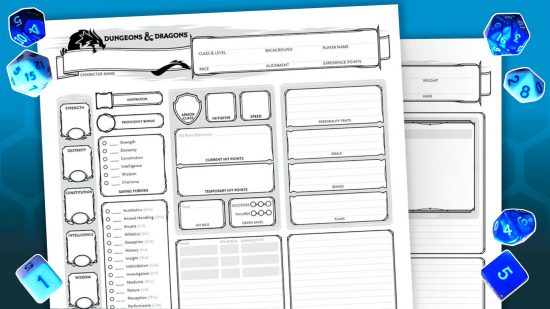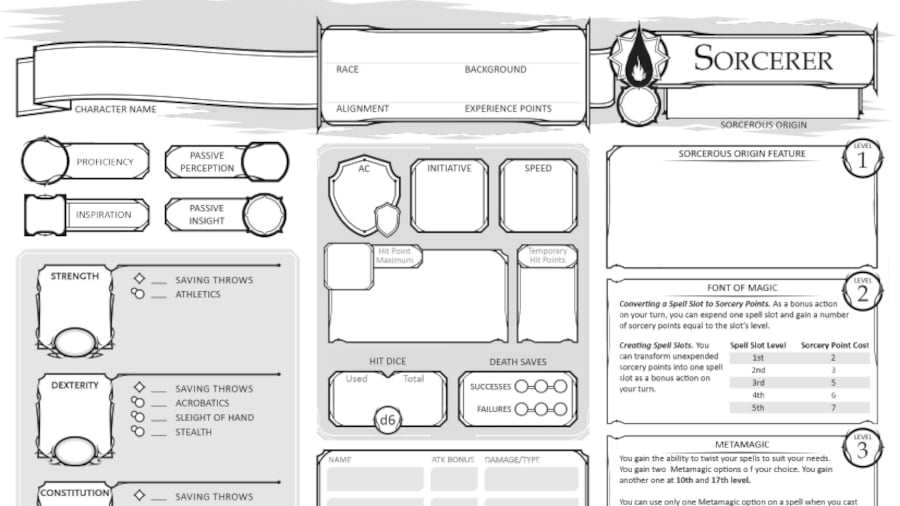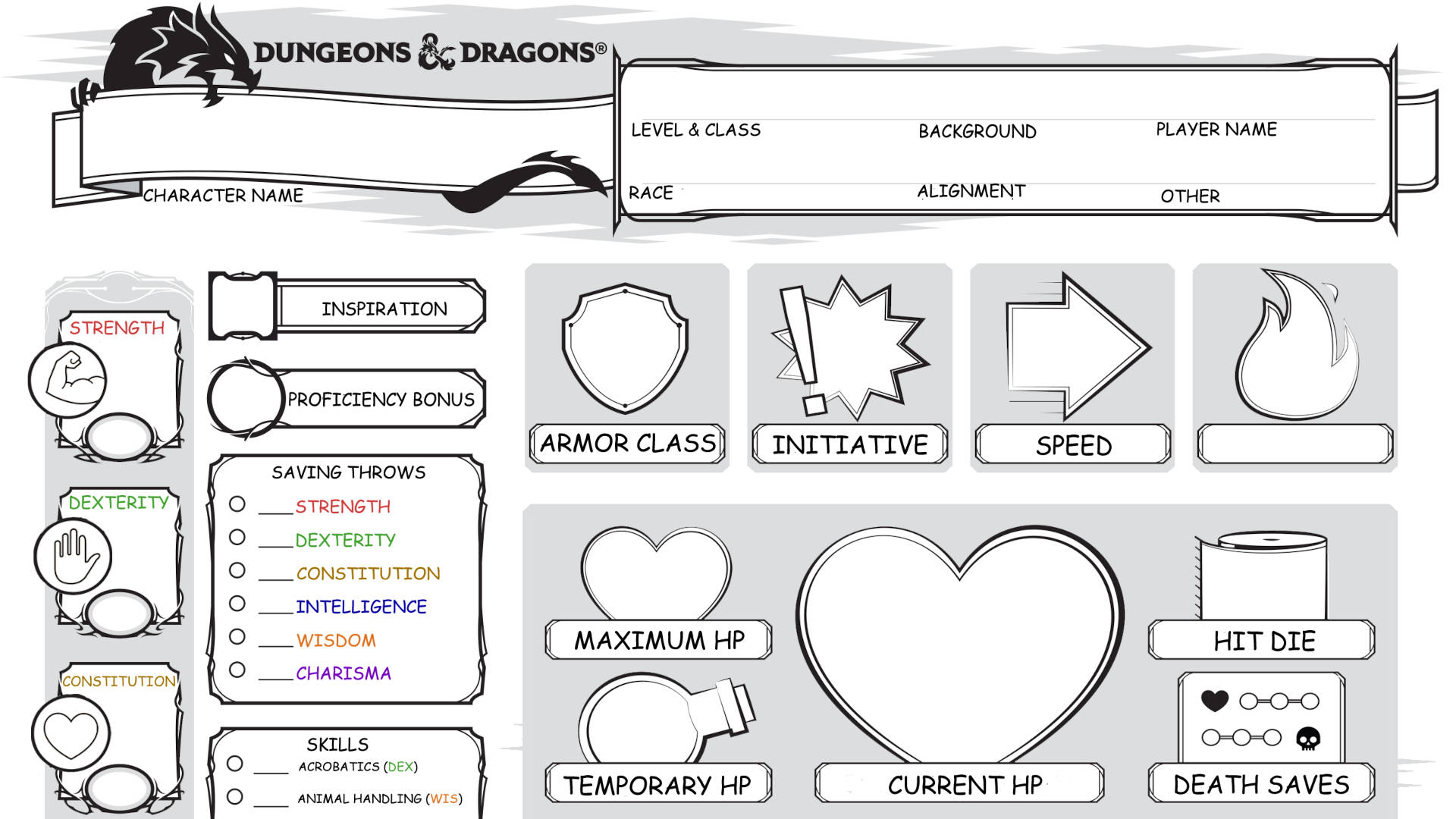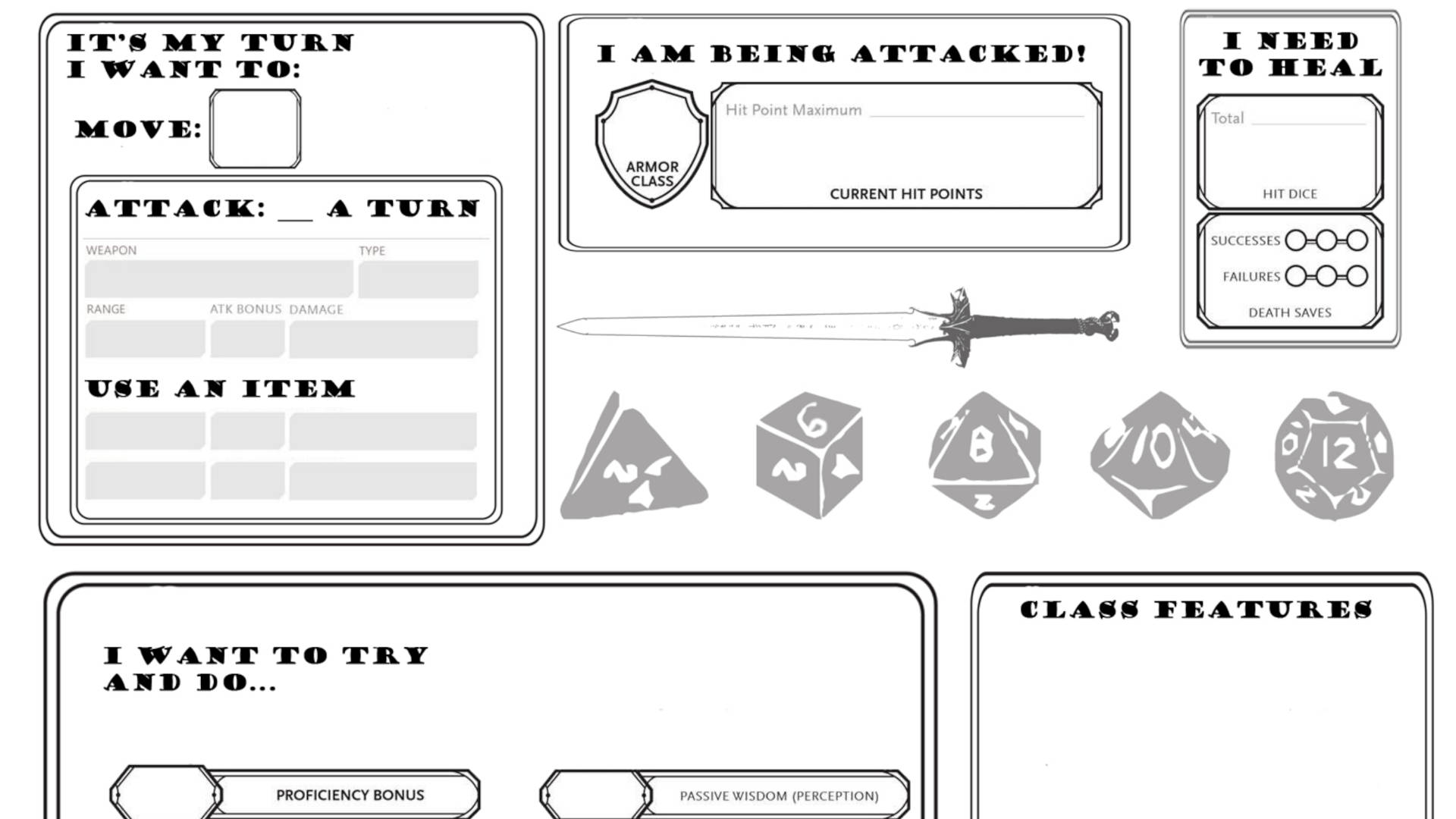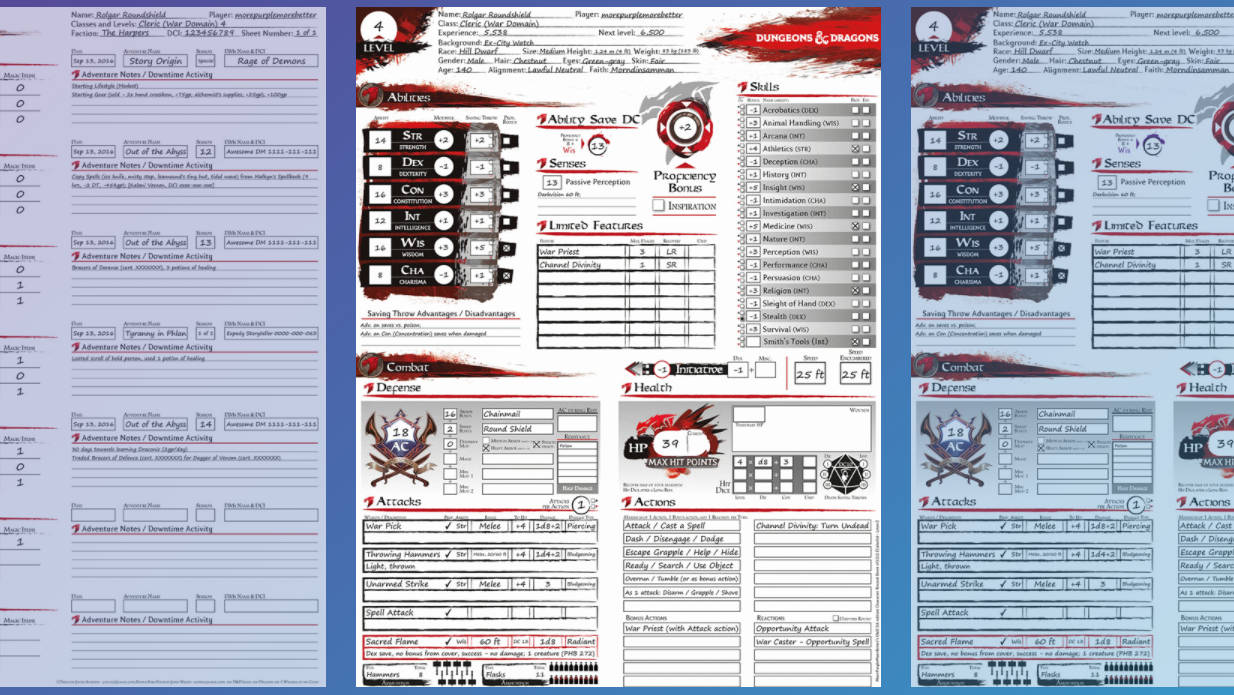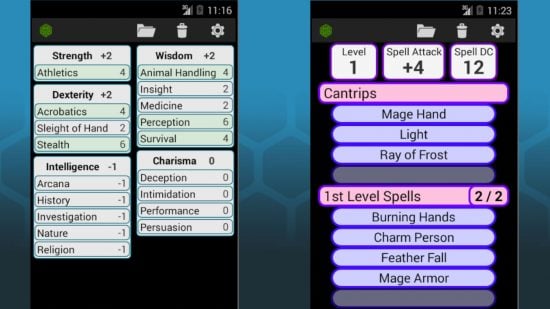In order to play a Dungeons and Dragons game, you need to build a DnD character sheet – a complete record of your fantasy character’s in-game stats, equipment, and more, to keep track of your adventure. Drawing on thousands of hours playing DnD, we’ve created this beginner’s breakdown of the official Dungeons and Dragons character sheet, as well as suggestions for alternative sheets to suit every kind of player.
We’ve designed this tutorial to work perfectly with our handy DnD character creator – so if this is your first time, we recommend using these two articles together to make the entire process a piece of cake. While we’ll explain all the key terms as we go along, having the Player’s Handbook and other core DnD books handy is also a great idea.
Whether you’re using a digital or printable character sheet, all the boxes and numbers on the standard sheet can be confusing at first – so we’ll break down each area in turn, with pictures and tips on how to fill everything in just right. Once you’ve got those fundamentals, we’ll explain a few of our favorite alternatives to use, including custom sheets for dyslexic and vision-impaired players.
Dungeons and Dragons character sheets made easy:
- DnD character sheet tutorial
- Choosing the best DnD character sheet for you

DnD character sheet tutorial
Since the standard sheet is the most common and one of the most complicated options, we’ve put together a DnD character sheet tutorial to help you use it. Let’s look at what goes in each box, step by step.
We’ll give a brief overview of any relevant rules, but if you need more information, be sure to check out the other Dungeons and Dragons guides provided in the links.
Character name
This one is simple. Pick a name for your character (from your own imagination or a handy DnD name generator), and scribble it here. If you want an immersive name that properly represents your character’s ancestry and culture, leave this box until you’ve chosen a race and background. Alternatively, go with your gut and decide to play a DnD Goblin called Boblin straight out of the gate. Each to their own.
Class and level
Your class is one of the biggest choices you’ll make when creating a character, and it’ll influence how you fill out many other areas of the character sheet. If you’ve not made your mind up, check out your options in our dedicated DnD classes guide.
Once you’ve picked a class, ask your Dungeon Master what level you’ll start the campaign at, and record this here. You may need to read up on the DnD level up process, particularly if you’re starting at levels three or above.
Background
Backgrounds offer a bit of flavor to flesh out your backstory, and they come with a few special abilities and skill/tool proficiencies. These aren’t game-breaking, but they’re nice to have on adventures. Browse the best DnD backgrounds, and record the name of your choice here.
Player Name
Your real name goes here. We’re sure you know your own name well, but this is helpful in case your Dungeon Master looks after everyone’s sheets between sessions.
Race
After class, your choice of DnD race is the next biggest decision you’ll make. It influences everything from your physical appearance to your ability scores. You’ll need to choose a race before you can fill out these boxes on the sheet, as well as your size, speed, age, and languages.
There are many varied races in the world of D&D, and the rarer options can be found in supplemental books like Mordenkainen Presents: Monsters of the Multiverse. The most common options, however, are those found in the Player’s Handbook:
- DnD Dwarf
- DnD Elf
- DnD Halfling
- DnD Human
- DnD Dragonborn
- DnD Gnome
- DnD Half-Elf
- DnD Half-Orc
- DnD Tiefling
Alignment
Your alignment determines your character’s moral compass. It’s mainly a roleplaying tool, but it occasionally has a mechanical effect in-game. Here’s a guide to DnD alignments to help you choose.
Experience points
Level ups are calculated in two different ways: milestone leveling or experience points. If your Dungeon Master uses the latter to decide when you level up, you can record how many experience points you have here.
Inspiration
Unless your Dungeon Master asks you to fill it in, leave this section blank at the start of a campaign. DMs will award a point of Inspiration to players during sessions. If you receive this gift, mark the box in any way you like to show that you currently have Inspiration. You can’t have more than one Inspiration point, so you won’t need to record a particular number here.
Proficiency Bonus
For many rolls (e.g. attacks and skill checks), you’ll be asked to add your proficiency bonus to a roll to the result. This number will change depending on what level you are:
| Level | Proficiency bonus |
| 1-4 | +2 |
| 5-8 | +3 |
| 9-12 | +4 |
| 13-16 | +5 |
| 17-20 | +6 |
Ability scores
The six ability scores in Dungeons and Dragons determine how good you are at pretty much everything. Any time you roll a die, the result will likely be influenced by a particular ability score modifier. For a full explanation of what each of the DnD stats means, check out our guide on the subject.
There are multiple ways to calculate your stats in D&D, so ask your Dungeon Master which they’d prefer you to use when filling out this part of the sheet. You might calculate your ability scores in the following ways:
- For each stat, roll 4d6 and ignore the lowest die result. Add the three remaining dice together.
- Assign the ‘standard array’ of ability scores (15, 14, 13, 12, 10, 8) in any order you like.
- Use the variant ‘customizing ability scores’ rules found in the Player’s Handbook (also known as the ‘points buy’ method).
When assigning an ability score to a particular stat, consider which are most important to the class you want to play. And don’t forget to add any ability score increases from your race to the final results.
Record this final number in the smaller, round box for your stat. The larger, square section is reserved for your ability score modifier, the number you’ll actually add to dice rolls.
| Ability score | Ability modifier |
| 1 | -5 |
| 2-3 | -4 |
| 4-5 | -3 |
| 6-7 | -2 |
| 8-9 | -1 |
| 10-11 | +0 |
| 12-13 | +1 |
| 14-15 | +2 |
| 16-17 | +3 |
| 18-19 | +4 |
| 20-21 | +5 |
| 22-23 | +6 |
| 24-25 | +7 |
| 26-27 | +8 |
| 28-29 | +9 |
| 30 | +10 |
Bear in mind that these starting ability scores are for a level one D&D character. If you’re starting at a higher level, you may need to tweak some of these ability scores based on how many level ups you’d have had before the game begins.
Saving throws
Saving throws help you avoid dangerous situations in D&D, and your Dungeon Master will let you know if you need to roll them. The class you choose will determine which saving throws you’re proficient in.
If you have proficiency, fill in the circle next to that particular saving throw. In the blank space next to these circles, record the modifier you will add to saving throw rolls. If you’re proficient, this is your proficiency bonus plus the relevant ability score modifier. For saving throws you aren’t proficient in, simply write the ability score modifier again.
Skills
Your class and background will determine which DnD skills you’re proficient in (see our guide for a full explanation of each). As with saving throws, mark the circles for skills you’re proficient in and combine your proficiency bonus with the relevant ability score modifier to calculate what number goes in the blank skill box. You can also write down the modifiers for skills you aren’t proficient in, but these are the same as the base ability score modifiers related to that skill.

Passive Wisdom (Perception)
If an enemy is attempting to ambush you, or you’re about to walk into a trap, the Dungeon Master may ask what your Passive Perception score is. To calculate this, add 10 to your Wisdom modifier. If you’re proficient in the Perception skill, you can also add your proficiency bonus to the final number.
Other proficiencies and languages
Any other proficiencies you get from your background, class, and race are listed here. This includes DnD languages, as well as tool, armor, and DnD weapon proficiencies.
Armor class
When a DnD monster tries to attack you, it must beat your armor class with its attack roll. When you’re not wearing armor, your AC is 10 plus your Dexterity modifier.
If you’re carrying a standard DnD shield, your AC increases by two. Different DnD armor also increases your AC score by various amounts.
Initiative
Initiative determines how quickly you act when combat begins. This box is used to record your Initiative bonus, which will be added to a d20 Initiative roll at the start of battle. Your Initiative bonus is usually the same as your Dexterity modifier, but character options like races and feats can modify this.
Speed
Your chosen race will determine your speed. Most Medium creatures can move 30ft in a turn without dashing, for example.
Current hit points
Here you’ll record your maximum hit points, as well as the HP you currently have. Each class has a designated Hit Dice, and their starting HP maximum is the maximum result on that die plus the character’s Constitution modifier. For example, a level one DnD Bard starts with eight HP plus their Con modifier.
Each time you level up, you’ll roll your Hit Die and add the result to your current HP maximum.
Temporary hit points
If a spell or other ability gives you temporary hit points, write them down here.
Hit Dice
You’ll be able to spend Hit Dice to regain health during a DnD short rest. As you gain levels, you’ll have more possible Hit Dice to use. ‘Total’ shows how many you have based on your level, and the rest of the box can be used to record how many you have left to spend during rests. The number returns to your total Hit Dice after a long rest.
Death saves
This section of the character sheet stays blank until your character drops to zero hit points. After that, you’ll need to roll DnD death saves. Record how many you’ve succeeded and failed by filling in these circles.
Attacks and spellcasting
When you make attack rolls, you add several modifiers to the final result. The attacks and spellcasting section can be used to list all your offensive options, with their attack bonuses pre-calculated.
Generally, a weapon attack bonus equals the relevant ability score modifier (Strength for melee weapons, Dexterity for ranged or finesse weapons) plus your proficiency bonus. Be aware that you only get to add your proficiency bonus if you’re proficient with that weapon type.
Similarly, spell attack bonuses can be calculated by adding your spellcasting ability modifier (Wisdom, Intelligence, or Charisma) to your proficiency bonus.
Some class features or DnD magic items may also allow you to modify your attack bonuses.
Equipment
Here you can list any notable items you start out with during your adventure (or pick up along the way). Your class and your background decide your options for starting equipment, and chapter five of the Player’s Handbook contains alternative rules for starting with gold instead.
This section also contains some boxes where you can track your wealth. D&D has four types of coin: copper, silver, electrum, gold, and platinum. Ten copper equals one silver, five silver equals one electrum, and two electrum equals one gold. Ten gold pieces are equivalent to one platinum.
Personality Traits (Ideals, Bonds, Flaws)
This section is for jotting down any roleplaying ideas you might have. Ideals represent your goals and values, bonds are your closest relationships, and flaws are…well, flaws. If you’re a bit stuck for ideas, your chosen background will suggest some typical personality traits for your character.
Features and traits
This is where you’ll jot down any unique abilities your character has. These can come from all kinds of sources, but your class and race will determine most of them. Document them in as much detail as you’ll need to remember how to use them. And don’t worry if the box looks a bit small – the second page of your character sheet has room for additional features and traits.
Beyond the first page
The standard DnD character sheet comes with two extra pages, but they’re less complex. The second is where you can write about your appearance, relationships, and backstory in more detail. Plus, there’s extra space to record any abilities or treasure you acquire on your journeys.
Page three is all about spellcasting. Here you can write the names of spells you know (though not how they work – there’s nowhere near enough room). Each spell level comes with a box for tracking total and used spell slots, and the circles next to each line can also help you track which spells you’ve prepared for the day.
At the top of the page, you can also write down your spellcasting ability, spell save DC, and spell attack bonus. You should already know your spellcasting ability and attack bonus from doing the calculations on page one of the character sheet. To calculate your spell save DC, add eight to your spellcasting ability modifier and proficiency bonus.
For context, here’s what a finished DnD character sheet might look like:
Best DnD character sheets for every kind of player
DnD character sheets aren’t a monolith, and there are actually many ways you might choose to record details about your character. Before you start rolling DnD dice to determine your stats, you’ll need to figure out how to record this information. Let’s weigh up your options:
Standard DnD character sheet
If you’ve even a passing familiarity with Dungeons and Dragons, you might be familiar with this 5e character sheet:
This is the standard DnD character sheet designed by Wizards of the Coast. Basic but sufficient, this version is designed to meet most players’ needs. The front page covers all your most important details – stats, skills, hit points, and so on. There’s even space for more fluffy details, like your personality traits and alignment.
On the back, you’ll be able to go into more detail about your character’s backstory. Here, you’ll record your age, height, weight, allies, and origin story. Finally, an extra third page can be used to keep track of the spells you might have learned.
There are some serious upsides to choosing this DnD sheet:
- It’s widely available for free, both as a digital, fillable PDF and a printable, physical document.
- Most players will recognize this sheet, so they can help you learn to use it if you’re feeling stuck.
That being said, this won’t be the right fit for everyone. The official DnD character sheet can be difficult to read, and if there are no tabletop RPG veterans around, you might spend a lot of time squinting at it with confusion in your eyes. (If this sounds like you, keep reading: we’ll go through a tutorial for this sheet shortly.)
Another downside to this choice is the lack of flexibility it offers. In attempting to cater to all D&D players, the standard character sheet becomes more fiddly for everyone to use. A DnD Fighter has no need for a sheet of spells, for example – so they’re stuck with a sheet of wasted paper.
If you think an alternative DnD character sheet might suit you better, here are a few options we’d recommend:
Class-specific DnD character sheets
Class-specific DnD character sheets revamp the basic sheet to include additional boxes and panels, specific to each of the game’s classes. There’s space to record your optional class features as you level up, your pick of subclass, as well as your mandatory abilities, such as the Barbarian 5e class’ Rage. There’s no chaff with these – everything you need to play your chosen class is ready and waiting on the piece of paper in front of you.
Depending on what class you choose, you might find this more or less complex than the traditional character sheet. This means it’s not necessarily the right pick if you want something simple.
Plus, you’ll need to spend some money if you want such a specific DnD character sheet. Our personal favorite class-specific DnD character sheets only cost $0.50 (£0.40) each, but a complete set costs $4.95 (£3.95). Consider how much you want to spend each time you play a DnD campaign.
Dyslexic-friendly and visually impaired DnD character sheets
Some Dungeons and Dragons players need a sheet that accommodates a disability or impairment. That’s no problem – these sheets are designed to make the game welcoming for all.
First up, check out some dyslexic-friendly DnD character sheets, designed by Twitter user Axelle. Axelle’s dyslexic-friendly DnD character sheets use a dyslexic-friendly font, as well as colors and shapes that make the sheet as readable as possible.
If you’d rather read a character sheet written in the OpenDyslexic typeface (specifically designed to aid the reading of those with dyslexia), consider these character sheets shared on Reddit. Bear in mind that they’re not exact reproductions of the standard sheet, with some boxes changed or missing, but they contain more than the bare essentials.
Those with a visual impairment might be interested in this character sheet on the Dungeon Masters Guild. Free to download, it’s a redesigned character sheet written in Arial Bold, in a large font, with large spacing, and color coding. Again, it’s missing some information, but it contains all the main elements, from races to alignments.
New player DnD character sheets
As the title implies, new player DnD character sheets aim to guide you through your very first campaigns. If you want a character sheet that arranges key information in a logical, simple way, there are plenty of options available to you.
This free character sheet on the Dungeon Masters Guild is a no-frills document that outlines basic combat rolls and spellcasting for those totally new to the game. This sheet, meanwhile, provides a handy list of the possible player actions you can take in a combat encounter, for those who might forget they can do more than wave their sword about.
Finally, this sheet highlights what a player can do on their turn, and explains what stats you need and rolls you need to make in common situations like combat or healing. Super simple.
Advanced DnD character sheets
If you’d like a character sheet you can customize to your heart’s content, you might be ready for a more advanced DnD character sheet. We recommend MorePurpleMoreBetters’ 5e Character Record Sheet (or MPMB, for short). Halfway between a full character builder and a typical recording sheet, MPMB is fully fillable, automated, and has all the optional pages you could want.
Fill a page with all the feats you’ve acquired, and companions found, or stick some handy rule references down. There’s a lot of customization here, including the ability to import your own scripts (or those you pluck from an internet forum) to add more content and functionality.
Its automation is the main draw, however. Being able to select a companion, have them automatically added to your sheet with all relevant stats, or generate a complete list of your known spells in an instant is a huge time saver.
This isn’t free, however, and requires a subscription to MPMB’s Patreon page to use. We expect this option will mainly appeal to veteran players who already know what they’d add or subtract from their perfect character sheet.
Mobile-friendly DnD character sheets
In a world of virtual tabletops and automated character builders, Dungeons and Dragons is becoming increasingly digital. This means you might prefer to save paper and use a mobile-friendly DnD character sheet instead.
D&DBeyond is our top choice for digital sheets. The free version lets you build a character with any material covered by D&D’s Open Game License, and you can use character options from any DnD books you’ve already bought on the marketplace. It works on both browser and mobile, and D&DBeyond walks you through the character creation process in a clear and approachable manner.
Every stat can be clicked to bring up an explanatory info panel, and ability rolls or skill checks can be made at the click of a button. It even shares dice scores in a shared log for each of your online campaigns, so you check no one’s cheating. And if you do decide to take your roleplaying out of the digital world, D&DBeyond’s character sheets can be exported into fillable PDFs.
If D&DBeyond’s interface is a bit too much, we also recommend the Fifth Edition Character Sheet. It’s a free app for iOS and Android that provides a simple but effective sheet for portable play. It’s not quite as polished as D&DBeyond, but it’s easy to pick up and definitely gets the job done.
By now, you should have your perfect character sheet, and perhaps even a completed character. Now’s a good time to think about what other RPG tools you might want to enhance your game. In-person gamers can spruce up their table with some DnD maps and DnD miniatures. For the DMs out there, a DnD encounter builder can help make campaign planning a breeze.
